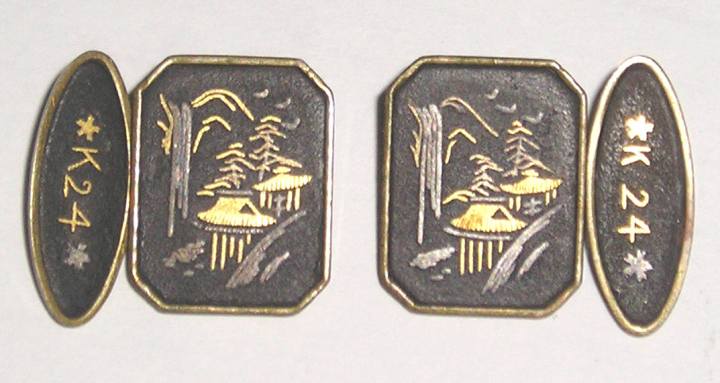
The ancient art of Japanese Damascene is by far my favourite style in mens vintage jewellery. I’ve seen some very beautiful tie clasps, cufflinks and chain-link cufflinks.
THE JAPANESE DAMASCENE HISTORY
It is believed the Damascene process was first brought to Japan over 2,000 years ago, reputedly form Damascus, through Korea. In course of time, Japanese craftsmen became skilled in its manufacture, and sword handles, helmets and other articles were adorned with Damascene. To meet the demand, cigar and cigarette cases, cuff-buttons, boxes, brooches, powder jars, and numerous other articles, decorated with Damascene inlay, are now produced in quantity. The United States and England are the largest buyers of this ware. Annually, more than half of the 300,000 Yen worth of Damascene manufactured in Japan is exported.
THE JAPANESE DAMASCENE PROCESS
Steel is the usual foundation of the articles, though bronze, silver, and gold are occasionally employed. Craftsmen, sitting cross-legged before a low bench covered with chisels, little hammers, and balls of gold and silver thread, fabricate the articles, which go through many processes before they are ready for marketing. The following explains the method.
The lengthy process:
- A design, first drawn on a piece of tissue paper, is placed over the metal surface and traced with a fine chisel into the metal, then removed.
- The outlines thus cut are undercut four times crosswise and four times diagonally (hatched) to produce something like a silken texture.
- Into these minute grooves, gold or silver (or both) threads almost as fine as cobwebs are hammered, and a deer-horn hammer is used to smooth the surface and tamp down rough thread edges.
- The article is then placed in a cabinet and made to corrode by the use of nitrate acid, which later is removed with soda water.
- When dry, it is washed twice in weak salt water and baked over a fire.
- Eight or nine times a day for a period of five days in summer and seven in winter, the article is washed and baked until all the rust in the steel has been conducted out.
- The clean surface is the dipped into thick red-clay mud and baked again over a hot fire.
- This process is repeated from 50 to 100 times.
- Next, the surface with powdered charcoal and oil, and baked.
- This is repeated from 10 to 20 times, adding more charcoal and oil each time.
- A piece of cryptomeria wood is used to clean off the black powder, and a small steel rod to rub the surface to a polish.
- The last step is to add any necessary carvings. Often these are monograms or handwritten names of the purchasers.
You can understand, from the lengthy process, why Japanese Damascene is such a treasured item. The time and effort in producing each item is very delicate and beautiful.
CARING FOR YOUR VINTAGE JAPANESE DAMASCENE CUFFLINKS & TIE CLASPS
Store your Damascene items in a soft cloth to protect from damage from other items.
To retain the original polish, your Damascene item should be rubbed once a month with a soft cloth dipped in olive oil.
Should the inlays become tarnished, rub them with a cotton cloth stretched over a fingertip.
Care for your vintage Japanese Damascene items and they will continue giving you love for many years to come.
See also:
Wizard Cuff Holder 1889
Tips for Buying Vintage Jewellery on eBay
The “Inside Secrets” of Vintage Jewellery Research
